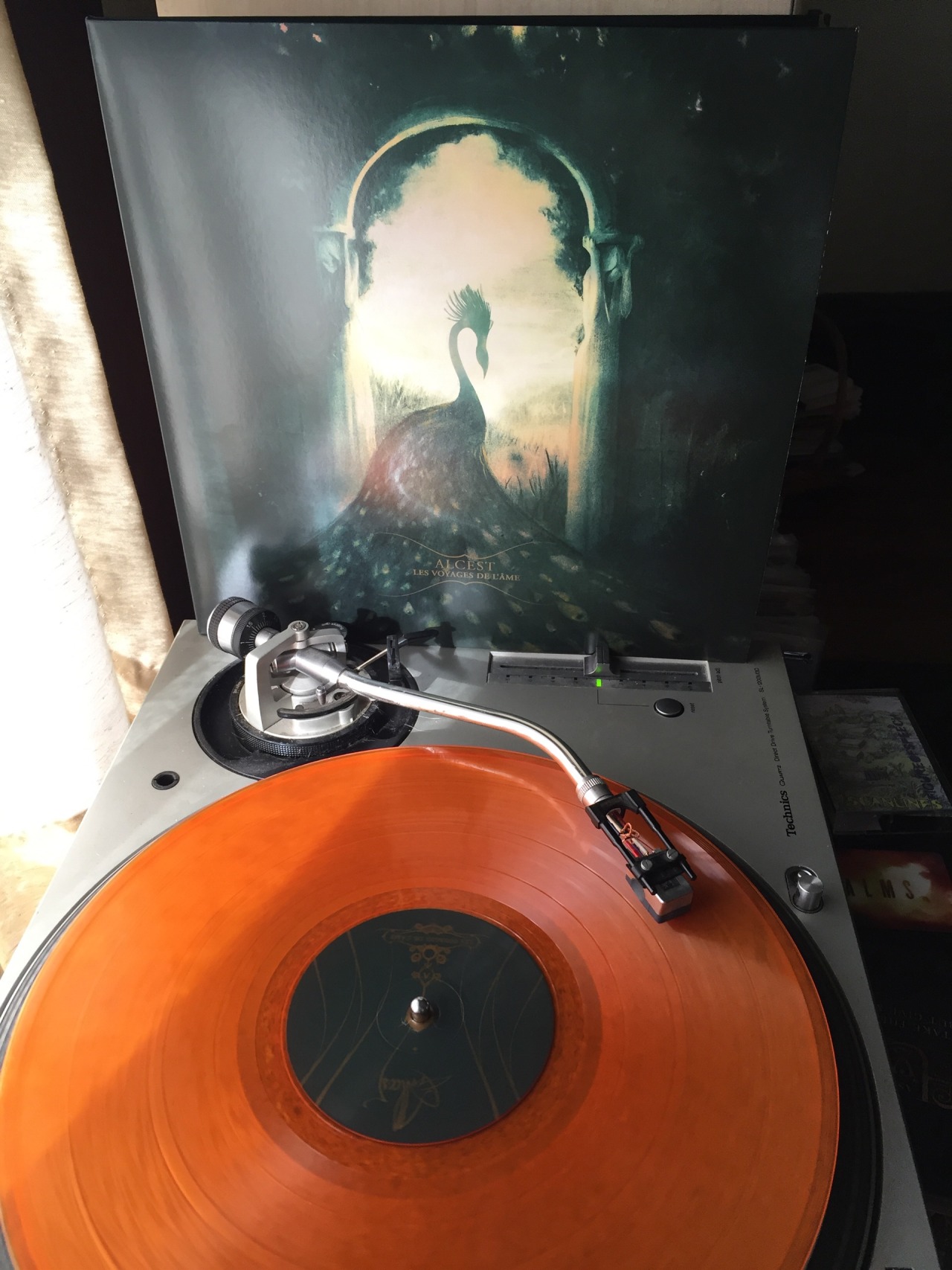Reviews
Record #331: Forever Losing Sleep – I Lost Myself Again (2014)
In this case, Forever Losing Sleep marries its SDRE-patented soft/loud dynamics and emotive whisper-to-scream vocals with post rock’s ambience.
Their live show show is absolutely spellbinding, and the record delivers on that. The production manages to capture every nuance performed by each of the six members as they fiddle with knobs or manipulate feedback without sounding canned. The songs are sequenced perfectly, combining together in a well paced whole. These aren’t only songs as much as they are movements in a larger, masterfully constructed composition.
Record #330: Alcest – Les Voyages de L’Âme (2012)
I don’t like a lot of metal (chuggity chugs, show yourself out. You too, obnoxious tapping solos), but the metal that I DO like, I absolutely love. ISIS, Palms, Jesu, Pelican, Russian Circles, Pallbearer, Deafheaven, Thrice (are too metal, shush), Wolves in the Throne Room…
I’ve joked that I like my metal like Ben Carson: black, not progressive, and kinda sleepy.
Dynamically, there’s a lot of soft/loud changes that black metal rarely gets into (never, if the purists have anything to say about it). Clean guitar lines saturated with reverb (more Perfect Circle or ISIS than Explosions in the Sky) tensely build into frenzied bursts of clanging drums and ripping guitar tremolos.
And while a majority of the album features sung vocals and less extreme drums, there are few moments of sheer black metal catharsis, shrieking, blast beats and all, like the climax of “Là où Naissent les Couleurs Nouvelles” (“Where New Colors are Born”) or the entirety of “Beings of Light” which would be a straight black metal song were it not for the ethereal choir and angelic alto that run through it.
Also, unlike most metal, much of this record plays in 6/8 time, giving a balladic feel even to some of the more aggressive numbers like “Faiseurs de Mondes” (“Makers of Worlds”). Closer “Summer’s Glory” restrains itself, pulling larger portions of cinematic post rock than metal to end the album on as victorious a note as they can muster, and they can muster quite a bit.
All in all, Les Voyages de L’Âme takes the most heartstring-pulling tricks from black metal, post rock, and shoegaze and throws them together in one beautiful, gorgeous whole. There’s not a bad moment on this disc–every second is aurally breathtaking and dripping with joie de vivre. And as someone who loves triumphant, melodic metal, Alcest is a revelation to me.
Record #329: Electric Light Orchestra – Olé ELO (1976)

But Olé ELO has more interesting origins.
As interest in Jeff Lynne’s group began to gain steam with the success of their huge hit Face the Music, United Artists Records compiled a retrospective of their past albums to give to radio stations. These non-retail compilations soon began circulating in the underground with such frequency that UAR had a commercial release.
And being that we’re talking about songs by Electric Light Orchestra, of course the music is great. The tracks are arranged chronologically, moving the album from hugely ambitious prog pop on side one to concise monster pop hits on side two. “10538 Overture,” with its “I Am the Walrus Vibe,” instantly exposes Jeff Lynne’s goal to continue what the Beatles had started by combining classical orchestration with modern rock and roll. And to that end, their eight minute reinterpration of Chuck Berry’s “Roll Over Beethoven” is a must for a collection like this.
As a big ELO fan myself, I’ve spent most of time with the albums following this compilation. As such, I enjoy this record as a good digest of everything I’ve yet to get into. And if it’s anything like the eleven minute epic “Kuiama,” I have some listening to do.
Record #328: The Evens – Get Evens (2006)
The entire instrumentation of the record begins and ends with the two voices, Ian’s Baritone guitar, and Amy’s drums. No overdubs, no distortion, no bass. Any fans of Fugazi’s final record The Argument will find no surprises here. The quieter songs on that disc form the basis of Ian’s guitarwork, while Amy’s drumming is filled with angular shuffles.
The lyrical content is vintage MacKaye–anticapitalist, anticonsumerism, antigovernment–but he’s never been more charming then here, particularly on “Dinner With the President,” wherein he asks why he’s never been invited over “(I live in town,” he says. “It’s not geography”) only to reveal the reason in the third verse (“I know just what I’d do…stand up and yell as the meal is served”).
While there’s nothing here that approaches the sheer heft of Fugazi’s monolithic catalogue, it would be a mistake to dismiss the Evens. Ian is just as sharp and witty as ever, and Amy is as formidable a writing partner as anyone else.
Record #327: BRAIDS – Deep in the Iris (2015)
Its follow up, Flourish//Perish, released fresh on the departure of their keyboardist, was a far more subdued affair, dwelling mostly in ambient electronica. It was beautiful, but not as pixie-devilish as anticipations demanded.
And so their third record, Deep in the Iris was released to almost no fanfare. As a BRAIDS fan, I only stumbled upon it by accident (and ignored it for a few months). Which is a shame, because with a hype machine behind it, this record could have been a huge hit.
For example, listen to the third track “Blondie,” whose structure is built on a wash of swelling keyboard chords paired with starting and stopping breakbeats. Anti-slutshaming anthem “Miniskirt” starts as a low piano led ballad before the drums and synths turn it into a dance track.
Given that they’ve always done both sides of their sound well, it’s good to see them here expertly combining them to create some truly engaging songs.
Record #326: Coldplay – A Rush of Blood to the Head (2002)
9-11 is fresh in our minds, the Strokes, Hives, and White Stripes have harbinged the Rock Revival, nu-metal’s studded leather boot is still kicking down our doors. Radiohead has released two electronic albums in a row.
40-Year Old Virgin hadn’t been released yet, so we were all ignorant to the fact that a certain band would make us gay apparently.
Into this cynical, hardened society, Coldplay released their second full length, A Rush of Blood to the Head.
Which was fine, because two things have always been true: 1.) Radiohead has always been too paranoid and suspicious of the ruling class to be the biggest band in the world, and 2.) Chris Martin “would give [his] left testicle to write an album as beautiful as OK Computer.” His words, not mine.
And A Rush of Blood to the Head is the closest Coldplay has ever gotten to that goal. That claim is going to piss off some people, most of whom haven’t listened to OK Computer recently enough to remember that its musical center is closer to “Let Down” than “Paranoid Android” (which actually sounds a little bit out of place). Rush of Blood, on the other hand, is a bit toothier than its reputation.
Wide-eyed in worldview and complacent in its composition though it may be, its not all “Scientist” and “Clocks” here. “Politik” is crunchy and wincing. Behind “Daylight’s” Arabic tinged strings is the most driving drum part Coldplay ever put to tape. “God Put a Smile on Your Face” throws its weight around by means of a ragged acoustic guitar.
“Green Eyes” and “Warning Sign,” with their perfect Mazzy Star vibes, would have been indelible 90s alternative hits had they been released eight years earlier. Whisper positively rips, remaining the loudest song the group has ever done. And “Clocks” and “Scientist”? They’re not bad tracks if you can isolate yourself from their overuse.
While Coldplay would go on to become parodies of themselves (I feel like I’ve said that before), here they are still making their mark on pop music, and who cares if that mark fits a bit snugly between a few other bands’ imprints? It’s a damn enjoyable record
Record #325: Flying Saucer Attack – Further (1995)
Acoustic guitars are woven through massive towers of delay and reverb, obscuring the vocals in the mix to the point where they are occasionally more of an additional texture than a verbal element. It is absent of percussion, except for “To the Shore,” the twelve minute standout of the album, which utilizes a galloping tom loop and arhythmic cymbal rush alongside a wash of single-chord guitar delay and feedback.
Though now twenty years old, Further is timeless, at once nostalgic and futuristic. Next to album and label information, the spine reads the phrase “HOME TAPING IS REINVENTING MUSIC,” which may not seem like a huge deal now, with Garageband preloaded onto every Macbook, ten years after Arcade Fire’s Funeral and Clap Your Hands Say Yeah’s debut broke open the floodgates of self distribution on the internet, giving rise to the advent of free distribution services like Bandcamp.
But in the nineties, where bands like Nirvana, Radiohead, and even underground heroes Sonic Youth and Jawbox were relying on major labels to finance and distribute their music, a loud call for DIY ethics was a radical slogan as punk rock as anything Fugazi had to say on the subject, even if the music is about as un-punk as you can get.
Record #324: Deerhunter – Fading Frontier (2015)
The Locket Pundt-led “Ad Astra” is a strong foray into new wave balladry (that coda though!). “Breakers” is the most crystalline piece they’ve ever done, with a breezy chorus that’s the best candidate for being used in an Apple commercial they’ve ever done. “Snakeskin” alone retains Monomania’s scuzzy funk, crashing with their first noise collage since Microcastle (“Ad Astra” has one too), an album whose weirdness makes several small returns throughout the running time.
It’s tempting to call Fading Frontier their most accessible album. It’s sleeker than anything they’ve done before (and about ten minutes shorter), and while they still get weird, they’ve learned to harness the beast of their weirdness and bend it to their will. But to call it accessible runs the risk of calling it more middle of the road, which certainly isn’t true. Maybe the middle of their own road, but who really knows where that road leads.
Record #323: Deafheaven – New Bermuda (2015)
There are more palm muted chunks, more blast beats, more big riffs, and fewer passages of soaring brilliance. Seeing that their masterful blending of metallic and melodic elements is what attracted me to Deafheaven in the first place (and back to metal and hard music as a whole), it made little sense to me to dwell on this album. After all, there’s still Roads to Judah if I need a break from Sunbather.
But on a whim, I decided to listen to it again, and I noticed a far richer story…
But as the record progresses, they turn down the distortion and borrow colors from alternative and post-punk. “Baby Blue” opens with a Smashing Pumpkins-esque, clean guitar arpeggio section before exploding into heaviness (now with a lead guitar line that would make Kirk Hammett green).
“Come Home” explores death metal, complete with chugging palm mutes and lower register growls, somehow managing to seam it together with their trademark metalgaze before closing with a beautiful slide guitar solo. The opening verses of “Give to Earth” almost reaches Joy Division territory with a clean, downstroked rhythm guitar and a cut time drum beat (George Clarke is screaming over this, mind you) before it explodes into wall-of-noise guitars (this IS Deafheaven after all).
All in all, despite it’s shift of scale, New Bermuda ends up feeling the same as Sunbather, even if it doesn’t always sound like it it. While it may not be as life affirming, it’s just crushingly beautiful.








